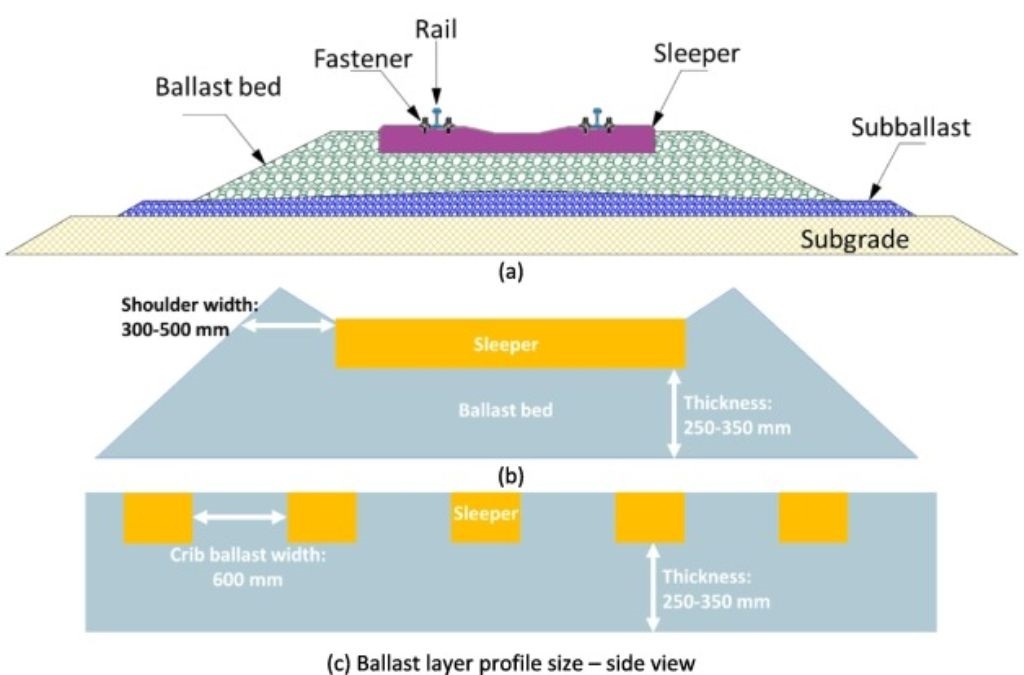Why are there stones on railway tracks? Today we will look into the answer to this very interesting question. You must have seen an endless pile of stones laid on the railway tracks. What is the science behind that? This centuries-old solution was solved nearly 200 years ago to facilitate the movement of people and material loads over thousands and thousands of kilometres.
Before we delve into the why, let us tell you that these stones along the railway tracks are called track ballast. What is that? Read further.
What is Track Ballast?![what is railway track ballast]()
The crushed stones along the railway track are collectively called track ballast. The term ‘ballast’ is derived from the nautical term used to refer to stones used to stabilize a ship. It was the crushed stone and gravel used for counterweighting British coal ships on their return voyage.
The track ballast forms the trackbed on which the railway lines are laid. The railway tracks are not fixed to the ground but rather float on the ballast. The weight of the ballast and railway tracks keeps the lines stabilized.
The track ballast is packed below, between, and around the railroad ties. The thickness of the track ballast is usually around 25 to 30 cm, sometimes more depending on the amount of traffic on the line.
A railroad track is made of two steel rails set apart parallel at a fixed distance. The rails are connected by railroad ties (referred to as sleepers in Europe) using a rail spike (a large nail also known as a cut spike or crampon). The railroad ties are made of wood or concrete. The rails are bolted to the ties.
Did you know? Robert Livingston Stevens is credited with the invention of the rail spike. The first recorded use of nail spikes was in 1832.
When is Next Solar Eclipse in 2024, 2025 and 2026?
What type of stones are used as track ballast?

Interestingly, only certain types of stones are used as track ballast. The materials used for ballast are generally high-quality igneous or metamorphic rocks which are blasted during mining from which desirable ballast material is obtained. Ballast material is uniformly graded and irregularly shaped.
The following materials can be used as track ballast on railway tracks: crushed rocks, gravel, coal ash (cinders), concrete, and sand.
Ash was once considered a good ballast material as it provided rapid drainage. Nearly 90% of the former North Eastern Railway was ballasted with ash in the USA till 1922. Studies state that ash could be a good ballast material however the presence of sulfides in the ash was a strong chemical hazard to the sleepers and also other track components. Therefore, ash was removed from the list of acceptable materials for railway ballast materials.
Purple Rain on Mars: What Is It? What Caused It? Know Significance
Why Are There Stones On Railway Tracks?
Above, we understood what rail ballast and the rail structure in brief. Let us understand why there are stones (track ballast) on the railway tracks. Track ballast helps to:
- Provide a trackbed for the railway tracks.
- Bear the compression load of the sleepers, rails, and rolling stock.
- Facilitate proper drainage on the tracks so that water does not stay on the tracks.
- Hold the tracks in place as the trains pass over it.
- Maintain track geometry against vertical, longitudinal and lateral displacements.
- Offer insulation properties and avoid problems with track power supply.
- Provide absorption of noise and vibration.
- Suppress vegetation on the track.

Comments
All Comments (0)
Join the conversation